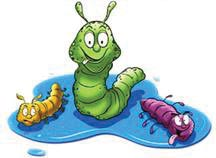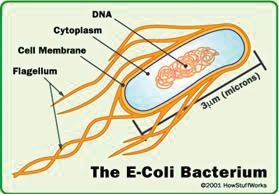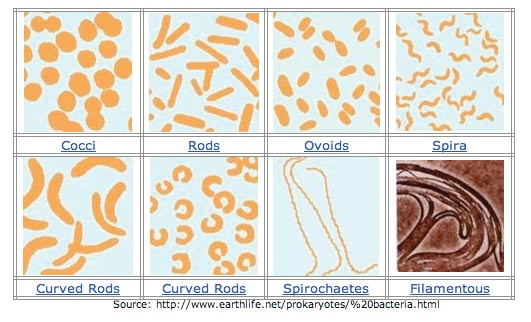Bacteria Fact Sheet
What Are Bacteria?
Whenever we hear the word bacteria we assume that something is dirty, our food is rotten, or someone is sick, but this is not always true! While there are many types of bad bacteria that can harm us by sneaking into our water and food, there are also many good types of bacteria that help us each and every day! There are bacteria in our stomachs that help us digest the food our body can’t, and there are bacteria in our compost piles that help turn food waste into new soil. So, what are these things we call bacteria? Keep reading to find out!
Bacteria are living things that belong to a group all by themselves. They are small, single cell organisms called prokaryotes that do not contain a nucleus and are usually found in very large groups because they can quickly multiply. There are many different kinds of bacteria that are all separated into different types and groups, each group having its very own unique qualities that sets it apart from all the rest.
Bacteria are about the simplest cells that exist today. A bacterium is a self-contained cell about one-hundredth the size of a human cell. The largest human cells are about the diameter of a single human hair, but most human cells are smaller... maybe one-tenth of the diameter of a human hair! Because these cells are so small, they are invisible to us... unless we look at them through a microscope. An Escherichia coli (E. coli) bacterium is an example of a typical bacterial cell, and a diagram of it is shown below.
E-Coli Bacterium
A bacterium consists of an outer wrapper called the cell membrane. Inside this membrane is a watery fluid called cytoplasm that is about 70% water. The other 30% is filled with enzymes (proteins the cell makes itself to use for energy). At the center of the cell is a ball of DNA. DNA is basically a pattern that tells the cell how to make its proteins. If you were to stretch out this DNA into a single long strand, it would be incredibly long compared to the bacteria... about 1000 times longer than the entire cell! The DNA of a bacterial cell isn’t protected; it floats in the cytoplasm. Attached to the outside of the cell are long strands called flagella, which allow the cell to move. Not all bacteria have flagella though - some have different ways of moving around.
Appearance of Bacteria
Although bacteria are microscopic, they do come in different sizes and shapes. The most common shapes are rods, cocci (circular) and spiral, and within these groups the bacteria may be large, small, oval, fat, long, short, and even thicker at one end than the other. The difference in size and shape of the bacteria is the result of them all having different genes (DNA). All of these characteristics are called the morphology of the bacteria. Bacteria may also exist as single cells, or in common groupings, such as chains, pairs and clusters.
Bacteria are an amazingly complex and fascinating group of creatures. While most bacteria must find food (sugars, proteins, vitamins) to live, some are able to make their own food from things found in the environment, like sunlight and carbon dioxide. Some bacteria need energy from the environment to make food, while other bacteria can create their own energy by using other elements in their surroundings.
There is also a great diversity in where bacteria can grow. Some types of bacteria grow best in cool, damp places like in the soil or in a pond while others can grow in hot places like in hot water heaters or near undersea volcanoes. There’s even a species of bacteria that can withstand blasts of radiation 1000 greater than would kill a human! No matter where you look, whether on the ground, in your water, or in your stomach, bacteria are there!
Bacteria that cause disease and make you sick are called pathogenic bacteria. Bacteria can cause disease in humans, animals and plants and can infect you by being in things you eat and drink. Enteric bacteria (bacteria that interact with your intestine) make you sick once you swallow them. In addition to E. coli, as seen above, some other examples of pathogenic bacteria are: Salmonella, Campylobacter and Legionella.
The amount of colony forming units (alive, healthy bacteria cells) you need to swallow in order to get sick depends on the type of bacteria. It is also important to consider that because bacteria are so small, it won’t take long for them to grow and divide and make more of themselves. When bacteria divide, each new cell is an exact copy of the previous one, as seen here:
Cell Division and Daughter Cells
Did you know that some bacteria can double their population in only 20 minutes? This means that if you started with 1 bacterial cell, it would only take 4 1⁄2 hours to have over 16 000 cells! It’s easy to see why there is such a concern about protecting ourselves from these organisms. It doesn’t take long for the bacteria to create enough cells to make you sick.
Although we’ve learned that bacteria are invisible to us without a microscope, there are ways that we can protect ourselves from the pathogenic bacteria even without being able to see them. It is important that you always wash your hands after going to the bathroom and blowing your nose. It is also important that you wash your hands before eating and before preparing food for yourself and for others. After eating a meal, make sure that any leftovers are packaged and put away in the fridge as soon as possible. It is also important not to drink any dirty water, including water from swimming pools, rivers, ponds and lakes. Even though the water may look clean and clear, those tiny bacteria cells could be there! If you’re careful, you can avoid the bad bacteria and know that the good ones are always there helping us out!
Did you know that bacteria can be useful in water treatment? Please help us to send more Operation Water Biology kits to schools! Please chip in $5 or donate $20 or more and receive an Official Donation Receipt for Income Tax Purposes - or donate $170 to provide a school with an Operation Water Biology kit.






